“Is Photography Art?” The History of this Question
It strikes me that photographers of all eras have suffered a sense of insecurity as to whether what they are doing qualifies as art.
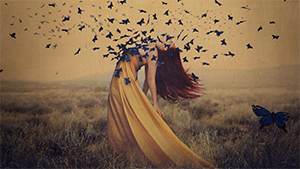
The challenge of the early photographer was to elevate their art above that of a merely scientific process. Today, this problem has largely been superseded by the need to separate the artistic from the mundane amidst the vast quantity of images produced by digital cameras everywhere.
The purpose of this post is a first attempt at assigning a historical context to the various photographic movements I have encountered and the styles or techniques associated with them. These include:
- Pictorialism, i.e., “arty photography”
- Modernism – experimental “wacky” stuff, influenced by cubism and surrealism
- Californian Modernism – technically perfect straight natural photography
- Reportage – shocking straight humanist photography
- Late modernism – extreme abstraction, minimalism, conceptualism
- Post-Modernism – constructed “snapshot” aesthetic; sometimes difficult for the untrained eye (I include myself here) to differentiate from images made by a child with a smartphone.
Although it is possible to indicate times when various approaches first appeared, or were most fashionable, many of these trends progressed in parallel, and are still around today.
Please help.
This is a long way from a comprehensive review of the major movements and is certainly a post I hope to revise over time. If you have any comments or suggestions please add them below or the social media channel of your choice to the right.
Thank you.
Origin of Photography – Straight Photography – Source of Anxiety
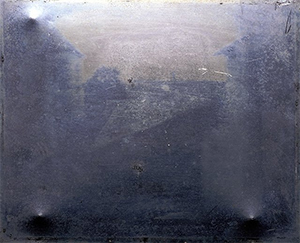
It is generally recognised that photography was “invented” in 1839 by Louis Daguerre, who less than modestly named the process the daguerreotype. The less pushy Nicephore Niepce, who invented the predecessor technology the heliopgraph and made the world’s first permanent photograph (shown to the right) in 1826ish, has been consigned to a footnote in history.
Critically though, 1839 was the year in which the French government purchased the patent for the daguerreotype, and gave it freely to the whole world; the “whole world” being with the exception of England and Wales where a separate patent arrangement was in place.
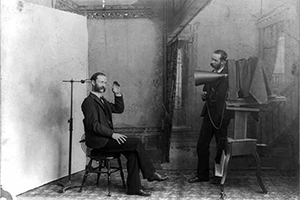
The patent was for a scientific process that copies nature, and this is how photography was viewed. However, copies of nature previously provided livelihoods for portrait and landscape painters. These professional artists now found themselves commercially challenged by a fashionable technology that could produce a likeness from a 10 minute sitting, as opposed to the multiple sittings over days or weeks required for a traditional painting. To address this, the painters looked for ways to up their game.
Straight photography was seen as scientific and representational, with both complementary and derogatory connotations. This attitude towards photography in the minds of the populace was later amplified by the role played by high street chemists, as white-coated retailers of retail camera equipment and development services. Experienced practitioners were rightfully indignant about being viewed as operators of scientific equipment. Even today, an effective way to wind-up a photographer is to say: “that’s a wonderful photograph, you must have a very good camera.” This time it was the photographers who needed to up their game.
Thus ensued a synergistic interplay between photography and the traditional arts with each developing in response to developments in the other.
The Advent of Pictorialism
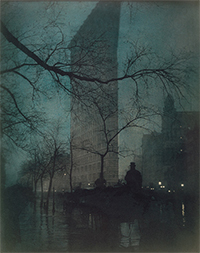
The drive to create something beyond the scientifically representational image of straight photography resulted in a photographic style, prevalent at the end of the 19th and early 20th century, in which the photographer “adds something of themself to the image” or makes it “more arty” by manipulating it in some way. Whereas the means of manipulation at the time were quite limited, the early pictorialists experimented with in-camera and darkroom techniques for soft focus, dodging & burning, multiple exposure, and collage.
Leading photographers of the day included:
- Alfred Stieglitz – the first American member of the prestigious British Photography Club the “Linked Ring” (an invitation only breakaway from the Royal Photographic Society) – returned to America where he formed a similar group called the “Photo Secessionists,” founded the journal “Camera Work” and Gallery 291 and adopts as his muse, and then marries, Georgia O’Keeffe.
- Edward Steichen – image right
- Henry Peach Robinson – English photographer who published the first book on photographic effects: “Pictorial Effect in Photography: Being Hints On Composition And Chiaroscuro For Photographers.”
- Clarence White – best know female photographer of the day.
Pictorialism was known at the time as “Art Photography.”
Modernism Generally
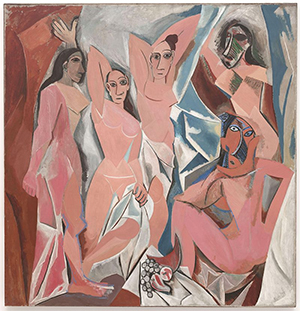
The late 19th and early 20th century saw considerable innovation in the art world This was stimulated at least in part by the rise of the photographic medium which promised superior accuracy in terms of a realistic likeness. This drove painters to increasingly experiment with abstract and more stylistic techniques. In particular,
- Impressionism – Monet. Renoir, et al. – term first used in 1874, albeit then in a derogatory manner
- Cubism – Picasso’s “Les Demoiselles d’Avignon”, 1907, is often regarded as the first cubist work
- Surrealistm – movement officially started by Andre Breton in the 1920s.
Leading photographers of the era:
- Man Ray
- Salvador Dali (photographer as well as painter)
- Paul Strand – first abstraction – influenced Georgia O’Keeffe when in New Mexico
The photographers of this period were heavily influenced by both cubism and surrealism.
The Californian Modernists
1920s-30s, in parallel with the experimental approach of East Coast and European artists, a group of San Francisco based photographers formed “Group F.64” (initially 11 photographers including Ansel Adams, Imogen Cunningham, Edward Weston and Willard Van Dyke as Weston’s apprentice). The group sought to show what a camera can really do with precisely exposed, clear, sharp images of landscapes and found objects. This was a return to “Straight photography” in its purist form; and directly counter to the romantic aesthetic of the Pictorialists.
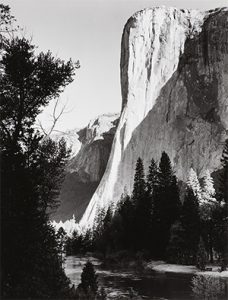
According to the Tate: “The overarching vision of the group was their belief in the camera as a passive observer of the world, better able to depict life as it really was because it did not project personal prejudices.” [A view now at odds with the generally held belief that photography is always subjective.]
Unifying characteristics of photography from the Californian Modernists:
- Always shot in Black&White
Even though colour photography had been possible since 1861 and was widely available in the early 1900s. - Large format cameras
- Sharp focus throughout the image
- Zone system to produce maximum tonal range.
The first gallery set up by Van Dyke in his home at 683 Brockhurst in Oakland was called “Gallery 683” as he said “specifically to thumb our noses at the New York people who didn’t know us.”
Reportage – New Realism – Humanist Photography
From the outbreak of World War I
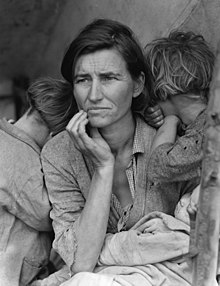
Reportage or “documentary photography” is the art of the story. c. 1914, this was again a reaction against the romantic fuzzyness of pictorialism which was no longer seen as appropriate in a world at war. As with all story telling, there is a predetermined intention to explain a particular social or economic phenomenon, and is often used to promote social change. This is not to be confused with photojournalism which usually refers to the coverage of specific events rather than dealing with the “big picture.”
Documentary photography dealt with dark subjects involving human tragedy such as wars, natural disasters, social inequality or the American Depression. Widely distributed, shocking images were used to shape public opinion.
1936 to 1951 a group of America’s most noted photographers formed “The Photo League” in New York with the goal of promoting a range of social and creative causes, and to “put the camera back into the hands of honest photographers who … use it to photograph America.” It was ultimately closed down by the FBI for being “subversive and anti-American.”
Leading photographers: Paul Strand, Dorothea Lange, Charles Sheeler and Edward Steichen.
Late Modernism
From the aftermath of World War II and continuing into the 21st Century the art world, Europe and the USA at least, have continued down the route of increased abstraction, with movements including:
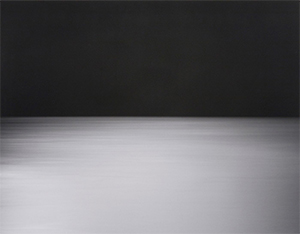
- Abstract Expressionism
The leading art critic of the time, Harold Greenberg, described Jackson Pollock’s work as: “gesture on canvas liberated from value – political, aesthetic or moral.” Which I think was supposed to be adulatory. - Pop Art
Most famous practitioner is Roy Litchenstein, followed by David Hockney who has worked across a number of styles in photography including his “Joiner” collages. - Minimalism & Post Minimalism
Paintings defined as “minimalist”, to use a euphemistic term, tend to be “less immediately accessible” as an art form; Agnes Martin, Barnett Newman, et al. Post minimalist works are presumably even more extreme and inaccessible. However, minimalist photographers such as Hiroshi Sugimoto and Michael Kenna produce work that is easily appreciated for its deep and simplistic elegance. - Colourists
Painters: Marc Rothko and Barnett Newman. Photography: colour theory is used by all abstract and other photographers to a greater or lesser extent, but is not, as far as I know, used in isolation.
Post-Modernism – Contemporary Art
1990s and onwards
In her excellent, and quite long, YouTube lecture sponsored by B&H, “Contemporary Trends in Photography“, Eileen Rafferty suggests that there are currently four dominant movements in photography:
-
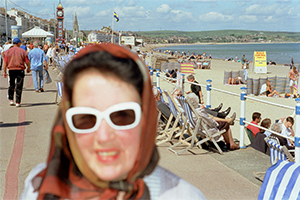
Martin Parr, Weymouth, 2000 England – The Snapshot Aesthetic Mixed Media
Combination of photographs old or new, with any other medium such as ink, paint or sculpture - Constructed Realities
The combining of elements from multiple photographs, sometimes hundreds or thousands, to create a “staged scene” which is either realistic or pure fantasy - Moving Image
i. Video – in art circles, usually used in installations
ii. Timelapse – great example is the BBC’s Planet Earth series
iii. Stop-motion – like time lapse but without equal time between shots
iv. Cinematography – only one part of an image moves. - Snapshot Aesthetic
Things we see everyday, perhaps viewed from a new perspective. Writing about Martin Parr, one of the genre’s leading lights, Dan Rule of “The Age” said: “Parr’s signature is his ability not only to isolate the most evocative of human details, but to elevate such visual fragments to that of the wider societal signpost or glyph.”
Personally, I appreciate the above art forms more when watching Rafferty’s video than I do seeing them live, as it were, at the Tate Modern.
References:
- Eileen Rafferty – YouTube – “Art Movements Through Photography“
- “Painting and Photography 1839-1914” Dominique de Font-Reaulx (Flammarion)
If you have any comments or questions about this post, please comment below. Or alternatively, connect with me through the social media channel of your choice right. In fact, please do that in any case!